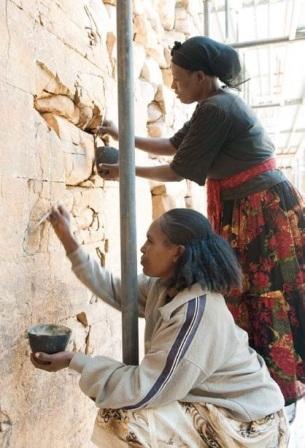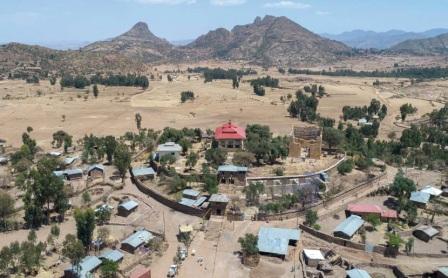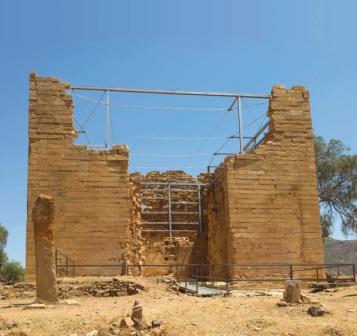About 3000 years ago in the province of Tigray in what is today Ethiopia, an entity named Di’amat emerged which was the result of immigration by population groups from Saba in modern-day Yemen. In the early 1st millennium BC, these groups together with the indigenous population established a network of settlements dotted along the trade routes. The Sabaeans brought a range of cultural techniques and expertise – their language and writing system, practical knowledge in agriculture, architecture, arts and crafts, as well as their religious, political and social institutions.
Yeha was the administrative and religious centre of this society. If one approached the settlement from the trade routes, the ancient palace and at least two religious buildings would have been visible from a long way off. One of the temples preserved to a height of 14 metres was built around the middle of the 7th century BC and dedicated to the main god of the Sabaeans, Almaqah. In the 6th century of the Christian era the building was converted into a church and is today still a sacred place.

Iris Gerlach, Director of the Sana’a Branch of the DAI’s Orient Department, and her colleagues have been working together with the Ethiopian Antiquities Authority since 2009 on a project to preserve the substance of this unique building. First of all they produced exact and detailed structural documentation and a damage assessment map. In the process traditional methods were supplemented by the most modern technologies including 3D laser scanning. The structural documentation served as the basis for the thorough restoration that followed as the next step. Restoration was essential as the structure was at acute risk of collapsing. The Great Temple was already in a partly ruinous state when the famed German Aksum Expedition visited Yeha in 1906. A disastrous fire had badly damaged the temple probably in the middle of the 1st millennium BC. The fire completely destroyed the entrance porch, originally supported – by six pillars, as well as the temple’s upper storey and its inner wall shell. This was the part of the building that needed urgent restoration and the installation of a steel supporting structure. In cooperation with the Ethiopian Antiquities Authority and the DAI ‘s own advisory committee on historical monuments, the DAI sought to identify solutions through discussion, so as firstly to provide static stability of the frail temple walls and secondly to ensure the restoration measures were acceptable from both a conservation and an aesthetic point of view. A workshop was organized in Adua, to which specialists from the Ethiopian Antiquities Authority and the Ministry of Culture, architects and statics experts from various Ethiopian universities were invited, who discussed different possibilities of stabilizing the Great Temple with construction history specialists and monument conservators.

It was important to involve the priesthood and the local population in Yeha. As the building is still considered a sacred place, every step in the restoration process had to be explained and permission for it had to be sought. All the institutions and individuals involved in the process were finally able to agree on a reversible plan that complied with good conservation practice and was also acceptable in aesthetic terms. The plan envisaged the installation of a high-grade steel structure to support the interior walls upwards of a height of six metres, allowing the Great Temple to be continuously used in the future by worshippers, pilgrims and tourists. Since it is a principle of the DAI to work in a sustainable manner, the project included training for local craftspeople.
Archaeological and historical research into the region around the religious centre of Yeha has been ongoing since 2009, and since 2016 as part of a twelve-year Ethiopian-German project funded by the German Research Foundation (DFG). The project is being carried out jointly by the DAI and Friedrich-Schiller-Universität Jena and augments the DAI ’s research into cultural contacts that existed between southern Arabia and eastern Africa.
Project: Iris Gerlach, Director of the Sana’a Branch of the DAI’s Orient Department
Cooperation Partners:
Friedrich-Schiller-Universität Jena
Chair of Semitic Philology and Islamic Studies
(Prof. Norbert Nebes)
Authority of Research and Conservation of
the Cultural Heritage (ARCCH)
Tigray Culture and Tourism Bureau (TCTB)
HafenCity Universität Hamburg – Universität
für Baukunst und Metropolenentwicklung,
Geomatics Laboratory
University of Leipzig,
Egyptian Museum – Georg Steindorf
Friedrich-Alexander-Universität Erlangen-
Nürnberg, GeoZentrum Nordbayern, Palaeoenvironmental
Department
TU Berlin, Construction History Research Unit,
Master’s Degree in Heritage Conservation and many others.
Source: Archaeology Worldwide, the magazine of the German Archaeological Institute
